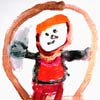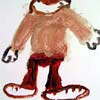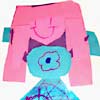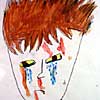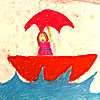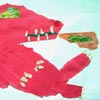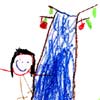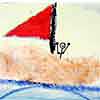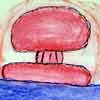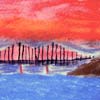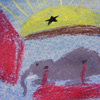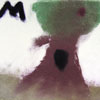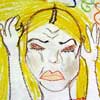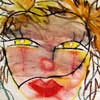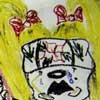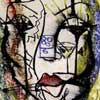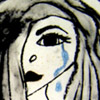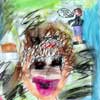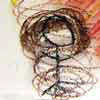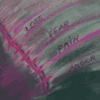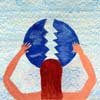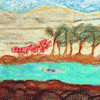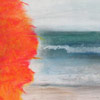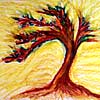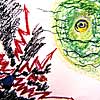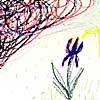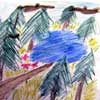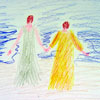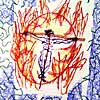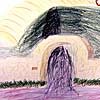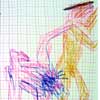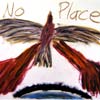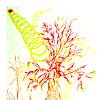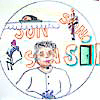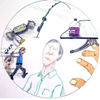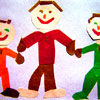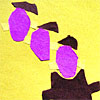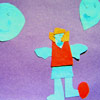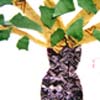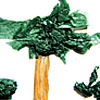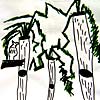
| Art Therapy | About Art Therapy | Client Art Work |
• Candace N. English mft •
| home |
| my practice |
| background |
| art therapy |
| services |





• About Art Therapy Art Therapy is highly relevant to Jungian and archtypal psychologies. As an action and image based therapy, it seeks to reconnect with and release ancient healing potentials which lie deep in consciousness. Art therapy is a process for reformulating the self through imagery. The art output provides a concrete record of change, which can be reflected upon by the client. For example, the ability to discern patterns in the art expression may lead the client to a further recognition of patterns in his behavior. Creating the picture helps to make the unconscious conscious. Once the image is in view, the process of its transformation may begin.
• Client Art Work The artworks featured on this and other pages of the site were created by clients I worked with between 1996 and 2002. They graciously extended to me the use of these artworks for educational purposes only. No personal details or clinical information are revealed, and all names and initials are changed. Any reproduction of materials on this site is forbidden under international copyright laws. I would like to thank these client-artists for their hard work and also to acknowledge their courage. The purpose of sharing their artworks is to illustrate the potential for inspiration, beauty and release that is offered by the art therapy experience. > click the image below to view the entire art work children | adolescents | adults | medical | couples | families • children The use of art and play therapies to treat children has become the standard of care in trauma cases as well as in many other presenting issues. In addition, normal children benefit from art therapy techniques designed to release conflicting feelings, build confidence and encourage self knowledge. The self-images presented here were created by elementary school kids participating in a social skills group. Through talking and sharing their artworks in small groups, the children practiced expressing their own ideas, as well as the art of listening and responding thoughtfully to their peers.
• adolescents Not all adolescents are willing to try art therapy. At some time, they may have heard that they are ‘not good at drawing’, so they became self censoring and reluctant to take the risk of an art experience. In these cases, non-art interventions may be the best choice. On the other hand, when adolescents are able to express their feelings with shapes and color, the outcome is often dramatic, like these works by middle-school boys.
12 - 13 year old boys
Adolescence is often a time of upheaval, uncertainty and rapid change, in which strong, unfamiliar feelings can seem overwhelming. Putting these feelings in a visual form through the act of applying color to paper is not only soothing and enjoyable, it stimulates a process of personal choice, overcoming obstacles and appreciation of outcome which can be seen as a metaphor for their developmental tasks. These drawings were produced by high-school aged girls.
• medical art therapy The branch of Art Therapy that pertains to physical illness is called Medical Art Therapy. It has shown significant efficacy in some pain conditions, as a supportive tool in the process of recovery from illness, and in coping with chronic conditions.
The client who made the drawings above was struggling with severe back pain and a diagnosis of compressed nerve root. In her case, the goal became to increase mobility and decrease pain. First she attempted to ‘draw the pain’. In the second we see her turned away and holding the weight of a broken world. Thereafter she set out to create a healing sense of flow, release and fluidity through her images. Eventually she came up with falling waters, rivers of color and finally, she was able to draw herself swimming freely in a beautiful pond.
• individual adults In art therapy, we seek to understand both the content meaning of the images and the process that created them as metaphors. We are looking at what the picture has to say about the state of the individual. Verbal connections are made to the images: ‘What direction is the stairway leading?’ ‘Where is the fire in relation to the ocean?’ Then, transformation is set in motion by client and therapist collaborating on the plan for the next drawing. Will the image become more distinct? Less rigid? Magnified? More open, colorful, or animated? The change brought about through transformation of image goes deep into a person.
• couples The couple whose drawings are featured here consists of an unmarried man and woman in their early 20’s. Already together for several years, theirs was a struggle to gain individual maturity as well as perspective on the meaning of their relationship. Her drawings are on the top row, and his are below.
The art expression of each is viewed by the other. What is revealed are both differences and similarities. Reflecting together verbally on the artwork, its process and content, can be fun and revealing. This is the “talk” part of art therapy--weaving connections through metaphor to life in the here and now and the issues that the couple came in to work on. The art expression’s transformation over time may reflect a deep change in the individuals, their understanding of one another as well as their self-knowledge. What is learned, experienced, healed in the art process, is applied to the every day reality.
• families | ||||||||||||||||||||||||||||||||||||||||||||||||||||||
©Candace N. English, World rights reserved.
All text and images on this web site are protected by international copyright lawsand may only be used by consent.

